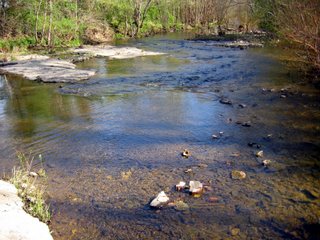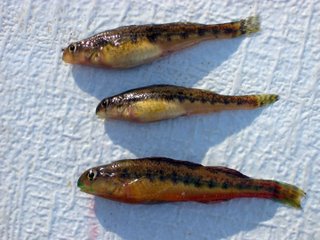We were going to go out today to a site we call "upper" Limestone Creek at Highway 53 in northwest Madison County. But according to weather radar, rain bands were still moving over our primary site on the Alabama/Tennessee state line near Ardmore around noon and local creeks were high so I postponed the outing until next Monday. Seining in an extra 30 cm of water during a thunderstorm just doesn't work for me.
Instead, I sat down with Christian, a student working with me on a funded undergraduate research project, and we examined a tabulation of her results examining fish for gill parasites over the last several months. We're looking at two species of fish, scarlet shiner (
Lythrurus fasciolaris) and striped shiner (
Luxilus chrysocephalus), to see how many
Dactylogyrus species Monogenean flukes are hooked on to their gill filaments (Monogeneans have a direct life cycle, with no intermediate host needed for their ciliated larvae). We chose the two fish species because they're very common in local streams but not well studied in most aspects of their ecology. The flukes range in size from 125 - 600 micrometers in length. Our procedure is to remove the entire right gill from a euthanized fish, make about five slides from the partitioned filaments and stain them with a Carmine Red stain for 48 hours before destaining them and examining them microscopically at X100 magnification to count flukes, if any.
We're focusing on collecting fish in three locations: "upper" Limestone Creek at Highway 53 near Ardmore, Madison County, AL; "lower" Limestone Creek along Mooresville Road, in Belle Mina, Limestone County, AL; and Swan Creek at Elkton Road in Athens, Limestone County, AL (see below for GPS coordinates). Limestone Creek is a surprisingly pristine creek running through still very rural areas. Swan Creek suffers from poor rural land use such as no riparian buffer so that the creek is prone to sharp flooding pulses. The water chemistry of all three sites is similar, with a pH of about 8 and Total Dissolved Solids (TDS) of 50 -100 ppm depending on recent rainfall.
So one possible variation we might see is different fluke loads between sites. We don't have enough data at the moment for a clear pattern to emerge, although Swan Creek may have a higher load in early results. Two other testable hypotheses involve fish size and species. In principle, a larger fish offers a larger target for the settlement of larval parasites, and the fish has also lived longer. And would one species of shiner tend to have more parasites than another shiner in the same environment?
A large number of
Dactylogyrus species have been described, on the observation that a given fluke species only infects one host species of fish. For instance, two species of
Dactylogyrus have been described that are found in striped shiners,
D. luxili and
D. manicatus (from a 1967 paper by Wilmer Rogers in
The Journal of Parasitology). I think we've found both of these species in our striped shiners, but in truth I can only tell them apart by size. What we've found to date is a weak correlation between fish length and parasite load in the 38 fish we've examined (29 striped shiners and 9 scarlet shiners). We've found some indication of more parasites in striped shiners than scarlets, 2.3 vs. 1.9 parasites per right gill. But we still have only a small data set.
GPS coordinates for sites:
Swan Creek at Elkton Road, Athens, AL:
N 34 deg., 49.406 min. W -86 deg., 57.092
Limestone Creek at Highway 53, Ardmore, AL:
N 34 deg., 55.194 min. W -86 deg., 45.871 min.
Limestone Creek along Mooresville Road, Belle Mina, AL:
N 34 deg., 40.535 min. W -86 deg., 52.725 min.
 This is Swan Creek, Athens, AL, looking downstream from the Elkton Road bridge on April 5. It's characterized by lots of limestone bedrock outcrops and limestone gravel. Water that day was pH 8.1, TDS 58 ppm and 20 deg. C.
This is Swan Creek, Athens, AL, looking downstream from the Elkton Road bridge on April 5. It's characterized by lots of limestone bedrock outcrops and limestone gravel. Water that day was pH 8.1, TDS 58 ppm and 20 deg. C. Above are three black darters, Etheostoma duryi, from Swan Creek. The top two are females, the bottom one is a reasonably well colored male. They were photographed on top of a cooler in the late afternoon sun just after being euthanized in MS-222. Note the blue-green patches on the male's snout and base of the caudal. We also found rainbow and stripetail darters in the creek.
Above are three black darters, Etheostoma duryi, from Swan Creek. The top two are females, the bottom one is a reasonably well colored male. They were photographed on top of a cooler in the late afternoon sun just after being euthanized in MS-222. Note the blue-green patches on the male's snout and base of the caudal. We also found rainbow and stripetail darters in the creek.